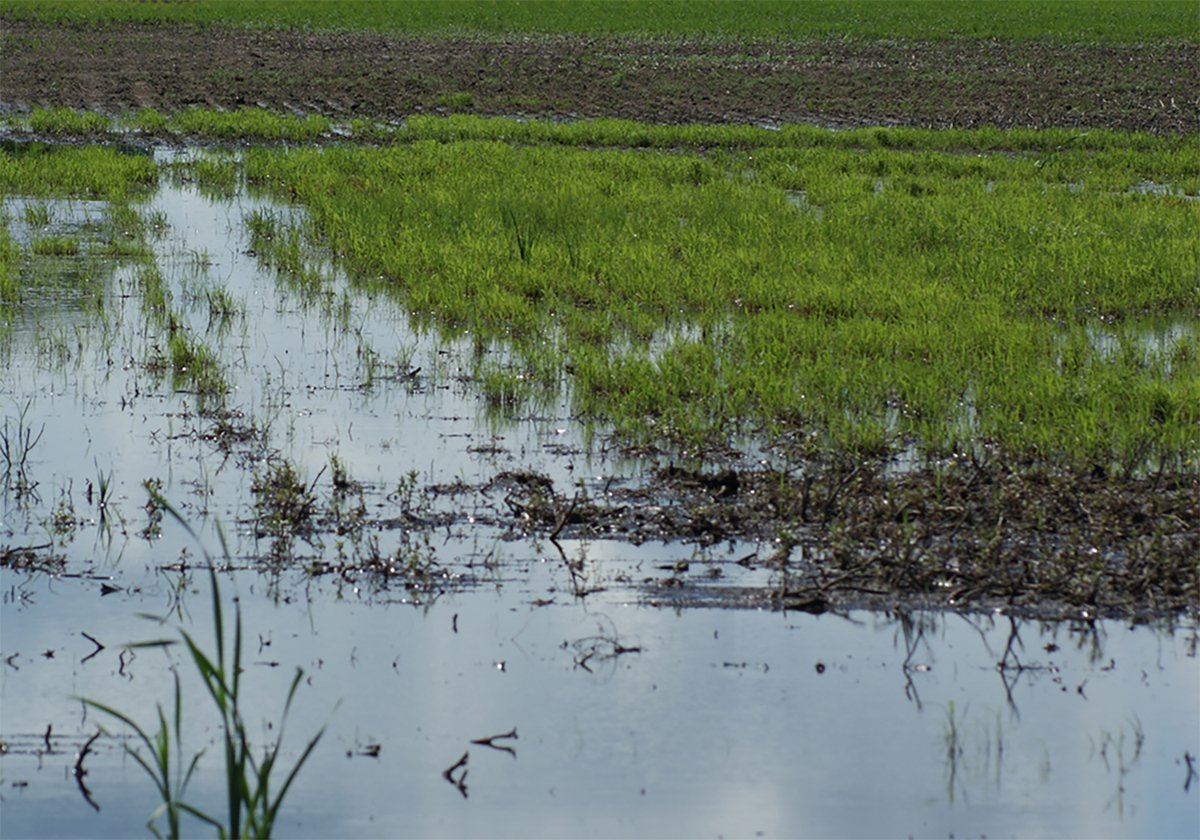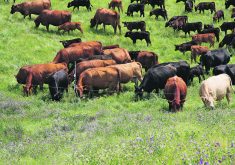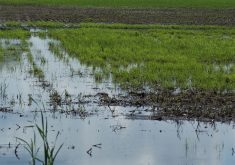Wake-up call
With the election of the Advisory Committee to the Canadian Wheat Board
in the odd number districts coming up in November, this letter is
intended as a wake-up call to the so-called silent majority to get
ready for action.
I am a retired farmer. I will not have a vote, but am intensely
interested in preserving one of the best institutions the country ever
had. I believe we still have a good majority who are supportive of
Read Also

Topsy-turvy precipitation this year challenges crop predictions
Rainfall can vary dramatically over a short distance. Precipitation maps can’t catch all the deviations, but they do provide a broad perspective.
single-desk selling under the CWB. Still, we cannot afford to rest on
our oats while the dual marketers are using devious methods to destroy
or undermine the one remaining marketing tool the farmers have left.
The latest move was when the agricultural committee of the House of
Commons came up with the suggestion of a trial period for dual
marketing. If the public has any understanding of the North American
Free Trade Agreement, they should know that if any such experiment ever
came to pass, we would be locked out from ever having single-desk
selling again.
With the last of our co-operative marketing institutions gone, the CWB
is the last remaining power the farmer has left in the marketplace.
With three big multi-nationals lined up against us plus the U.S.
government, who is committed under their free-market ideology to bring
the rest of the world to heel, we had better not become apathetic.
Don’t forget to remind your neighbours that the CWB is not a company
buying grain, but an agency set up by farmers with government
assistance to market their grain for them at cost, which has been
minimal. …
Those of us who were farming before we had any organized marketing
through our co-operatives can remember how helpless the individual was
in regard to dockage and grading.
Together with the Canadian Grain Commission, a much more just system
was established. With the establishment of a quota system for
deliveries, every farmer, large and small, was given equal opportunity
in deliveries.
We had to fight hard to get to where we are today. Don’t let us lose it
all by becoming gullible victims to those who rant about individual
freedom. …
– William Sloane,
Pilot Mound, Man.
Real farm
Bradford Duplesia’s very personal attack on myself and Dr. Doug Powell
does little to promote open and honest debate around a number of food
issues that concern the Canadian public.
As a society we are growing more distant from a direct connection to
food production. Farms and farmers are getting fewer, larger and more
productive as knowledge and technology allows. However, Mother Nature
still throws curve balls to us farmers. Some we catch, some we miss.
The challenge around the complexity of the decision making farmers face
is one society may not fully understand, but I would argue is one that
society is willing to embrace.
We have the luxury of choice in our country regarding how we want our
food produced. Although Duplesia is apparently too busy lobbing sound
bites instead of actually visiting the farm (despite numerous
invitations to do so) he fails to understand that food production is
anything but black and white. We openly talk about organic as an option.
We have a three-acre plot in transition to organic. Our climate here in
Ontario, with high management horticultural crops, will provide a
challenge to moving organics ahead, but we are committed to make this
work.
As a farmer, my concern over both my own economic well being and that
of my fellow farmers is one I can’t ignore, anymore than any other
segment of society. Duplesia’s claim that “anecdotal evidence by farmer
Jeff Wilson as proof” being the sole research into the monarch
butterfly issue is absurd.
Science invested huge resources to address an issue the public embraced.
While what I see on my farm is real, let others see the evidence as
well, along with the science facts to support the conclusions. The farm
is, after all, open to the public seven days a week.
Bradford refuses to acknowledge what the effects of a regular, approved
regime of pest management potentially could do if a population of
monarchs were in a field. The selective elimination of facts serves no
useful purpose if the goal is to stimulate thoughtful debate in the
public.
What we do here is real. We have made every effort to include
suggestions to make our work more defendable, relatable and
understandable.
An informed public is one I’ll always depend on. How does Duplesia
explain the overwhelming support our customers are showing for
genetically modified potatoes and sweet corn? The number one question
we continue to field is where can people get Bt potatoes for their
backyard gardens.
– Jeff Wilson,
Orton, Ont.
CWB respect
I read with interest (that) CWB election rules need enforcers. My view
of anything run by farmers is not worth the powder or paper that is
wasted to run it.
I have lived and farmed in the Eastern Irrigation District over 40
years. I have seen very little respect, if any, by board members
elected to run the district for farmers that elected them. And only
regulations that exist would apply to farmers only.
And board members do not feel obligated to correct any mistakes by them
or their engineers or employees and ignore any letters sent to them.
– John Pokorney,
Tilley, Alta.
NISA folly
Re: Vanclief orders faster NISA cheques (Sept. 5)
It’s all hooey. In July, Canada and Ontario announced they would spend
some of Ontario’s Market Revenue surplus by contributing an extra one
percent of eligible net sales to farmers’ 2001 Net Income Stabilization
Accounts.
Now that we have received the NISA update notices for that enhancement,
the complete folly of using NISA to deliver farm aid has become
abundantly clear.
One of my tax clients has two options:
(1) Contribute $2,181 (one percent of his 2001 eligible net sales of
$218,100) to his NISA account and receive matching government
contributions, which are not taxable income in 2002.
(2) Do not make a deposit, but use his minimum income trigger to deem a
government deposit of $2,181, which is taxable income in 2002.
In both options, the government contribution goes directly to NISA, and
my client can’t get access to his money until at least 2003. In both
options, my client’s taxable income for 2002 goes up by $2,181 because
in option (1) the NISA deposit is made with after-tax income on which,
by definition, tax has already been (or soon will be) paid.
The only difference between the two options is that in option (2) the
client can use his cash to buy an RRSP to offset the income from the
NISA benefits he can’t spend.
In option (1), his cash has gone to NISA.
We have chosen option (2) as the lesser of two evils.
If, however, the money had been put into the Market Revenue program (or
any other program of a similar nature) for immediate distribution, as
farm groups had pleaded, he’d have exactly the same $2,181 in extra
taxable income, but he’d at least have the cash to show for it.
Therefore, claims by the government that putting money into NISA will
enhance farmers’ income tax options is, for at least one of my clients,
completely preposterous.
Furthermore, claims by the government that putting money into NISA will
enhance cash flow is, once again, for at least one of my clients,
equally preposterous.
The only cash flow consideration facing my client is the extra income
tax he may have to pay either on money he can’t get at, or which he has
sent to NISA.
Only in Canada could increased farm aid cause increased cash flow
problems.
– Stephen Thompson,
Clinton, Ont.
Drought effects
One has to see the effect of the drought, which covers two thirds of
the prairie provinces, to appreciate the repercussions it has on those
living with it.
Old timers say that it is far worse than the drought of the Dirty
Thirties.
It was a sad sight in the areas surrounding Saskatoon, Rosetown, Biggar
and Prince Albert to see crops six inches high, in mid-July, when they
should be two to three feet.
They were brown and thin when normally green and lush, and there was
only the odd bale of hay when there should be many. Cars were plastered
with grasshoppers.
It is very evident farmers and families need direct financial support
immediately or many will be forced off their farms to find work
elsewhere.
Farmers hope that a hailstorm will take them out of their misery.
However, crop insurance does not provide a sustainable income.
It was gratifying to see farmers in the Ottawa valley providing hay for
the livestock producers in Alberta and Saskatchewan. It was a
thoughtful act of kindness even though they realized it was far short
of what was required.
Farm income in Saskatchewan is predicted to be 70 percent less in 2002
than in 2001, and 2001 was not a good year. Our federal government
intends to offer $5.2 billion to aid Canadian farmers but few farmers
on the Prairies expect to see any immediate cash. They feel that
administration will use up most of it.
About $100 million is to be used to convert marginal land to grassland
and to plant trees for shelterbelts, which adds no immediate financial
relief.
There is $10 million slated in 2002 for water supply projects, which
will not help producers who now cannot support their livestock without
immediate feed and water.
How will this affect you? The cost of meat will substantially increase
over the next few years as breeding stocks are now being marketed
rather than letting them starve. Expect increased costs for other
agricultural products because of reduced grain yields.
The Prairies may seem a long way from Ottawa, but the future economic
impact from this drought will bring it very close to home.
– Orrin Clayton,
Ottawa, Ont.
Hay screening
I would like to comment on the free hay given by the caring farmers in
the east. What they did was great beyond all words.
It started out so good but was ruined by intervention of some people
with a total lack of understanding that were put at the helm of the
project, and by others obsessed with greed.
In my opinion, there should have been no free hay. The lucky people
getting their names drawn should have paid a fee of maybe $50 a bale.
This fee could have been used to pay the freight bill for more hay to
be sent, thereby helping more farmers. Also, there should have been
real screening done on applicants. One of the applicants receiving hay
sold the hay for profit, and it was not the intention of our brother
and sister farmers in the east for people to benefit in this way.
– Richard Olson,
Vilna, Alta.














